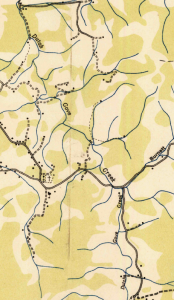People of German descent are one of the largest ethnic groups in the United States. They came to be known by the misnomer “Dutch” because Germans refer to themselves as Deutsch. Germans’ persistent and hardworking nature allowed them to thrive in backcountry settlements such as the Southern Appalachians. People of German heritage have contributed greatly to American society and culture. They like other European Americans left their homeland to escape poverty, hunger, religious persecution, and establish a better life.
Intolerable Conditions
The majority of German immigrants to the United States were from the Palatinate, a fertile area of the southern Rhine River Valley. In the 17th and 18th 
The Palatinate was repeatedly invaded during the Thirty Years War, (1618-1648). Invading armies burned towns and crops across the Palatinate during this conflict. Before the region could recover from this terrible devastation, Louis XIV, king of France, renewed the persecution of Protestants. His armies invaded the Palatinate multiple times in the 1680s and 1690s to bolster France’s claims in the region. Then natural disaster increased their hardship. The harsh cold of the winter of 1708-1709 killed fruit vines and trees, froze wine in
Immigration and Pennsylvania
One of the most inviting areas for the people of the Palatinate to settle was the colony of Pennsylvania. William Penn, founder of Pennsylvania, a devout Quaker, hoped to make his colony a haven for all Protestants. Penn personally
The port of Philadelphia was the primary landing place for immigrants arriving directly from Germany. In the spring of 1709, approximately one thousand Germans arrived in the British-American colonies per week following the harsh winter of 1708-09. By 1776, approximately 110,000 Germans had immigrated to the British-American colonies. The majority arrived in Pennsylvania, but as competition for good land increased, the Germans, like their
Germans in the Shenandoah Valley of Virginia
The first European to see the Valley of Virginia, on August 20th, 1670, was a German named John Lederer. Lederer had been hired by Virginia governor, Sir William Berkeley, to gather information on the Blue Ridge Mountains.

The fertile Shenandoah Valley between the Blue Ridge and Allegheny Mountains attracted settlers looking for good land to farm. The earliest German settler in the valley was Adam Miller (also
In the early 18thcentury, increased French activity in the Ohio country prompted Virginia’s government to take actions to defend the Old Dominion’s western claims. Therefore, in 1730 Virginia’s laws were changed to grant land speculators a thousand acres for each family they could settle west of the Blue Ridge, a law intended to create buffer settlements, of primarily Scots-Irish and Germans, in the mountains to
Recently arrived immigrants from Germany finding less land available than they had hoped for in Pennsylvania, along with second and third generation settlers, gladly took up the offer of cheap and fertile land in the Shenandoah Valley. Large numbers of Germans from Pennsylvania swept into the valley before and during the American Revolution. After the Revolution, Germans pushed into the Southern slope of the valley below Lexington. This protected and profitable valley became a predominantly German area before the 19th century.
Germans in the Mountains of North Carolina
For frugal German
Wachovia’s population had migrated directly from Pennsylvania. A few other German families came west from New Bern on the East Coast which was settled by German-Swiss in 1710.
The Dutch Cove area of Haywood County, located to the southeast of Canton, NC. Image from 1935 U.S.G.S. map.
German settlers generally settled in the same areas as their
1
2
3
4
For more information
- Drake, Richard B. A History of Appalachia. Lexington: The University Press of Kentucky, 2001.
- Faust, Albert Bernhardt. The German Element in the United States. New York: Arno Press and the New York Times, 1969.
- Von Hagen, Victor Wolfgang. The Germanic People in America. Norman: University of Oklahoma Press, 1970.
- Nicolas Sanson, 1692 – Partie Occidentale du Palatinat, 1692, Wikimedia Commons, Map by Nicolas Sanson.
- Shenandoah Valley 1801-1805, Wikimedia Commons, Shenandoah Valley.
- DTabCam,
Plotthound , November 30, 2009, Wikimedia Commons, Bossplotthound . - Ad Meskens,
Contestoga Wagon, (1883) by Newbold Hough Trotter, State Museum of Pennsylvania, 2009, Conestoga Wagon.


